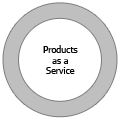
The Circular Economy Toolkit - 5 Minute Opportunity Assessment Tool
The opportunity assessment tool has combined literature, survey results and observations from workshops. The assessment tool will provide an indicator of potential areas for business opportunity or improvement according to the product design and your business operations. Greater benefit may be seen according to industry, product, positioning in the value chain, relation with the customer etc. The opportunity assessment tool should be complemented by reading the toolkit, case studies, using the tools provided and by running your own workshop.
What next?
Once you know the areas of potential greatest opportunity, read more information in the toolkit and use more of the tools explained. Start thinking how your business could start making money out of these opportunities through offering new services, product re-designs or by satisfying the customer need to make and support more sustainable, circular products.
Why not set-up your own workshop to validate your findings and start implementing some of these opportunities?
How does the tool work?
For design, manufacture and design, usage and recycling phases, the product design alone is considered and a ranking is placed according to an average of the results (low = 1, medium =2, high =3).
For extensions to existing services (maintain/repair, reuse/redistribute, refurbish/remanufacture and products as a service) results are taken from each section and the opportunity (including financial viability and market growth potential) is considered against the current product design. Each line is taken in to account and an average taken for the results for the opportunity and feasibility. The results are then plotted on the 3x3 matrix below. If there is high business opportunity and the product design is well suited, it's rated as a potential 'high opportunity'. If there is little business opportunity and the product design does not aid the service, then it's ranked as a lower opportunity, as shown here:

The tool doesn't give the answers I was expecting?
The tool has been designed to capture current product design and business operations. A change in either will affect the size of the opportunity. For example, if there is a strong market for remanufactured goods, but the product design does not support remanufacture, then the opportunity will be ranked low. If a product redesign took place to make the part say easier to disassemble and more modular in design, then the opportunity would increase.
It should be noted that the assessment tool considers your results against best practise e.g. using 100% fully recycled materials is excellent for the Circular Economy, however it might be technologically unachievable. The assessment tool is unable to assess the difficulty for your business to further stretch the product or service performance. This needs to be undertaken in more thorough discussions and analysis.
The tool also does not consider the tendencies of the customer. For example, if the product is sold to the consumer market then there may be a greater opportunity to sell more sustainable products which could be sold at a premium. These are considerations that should be taken in to account in the workshop where opportunities are prioritised.
The Opportunity Assessment Tool offers a simple grading of opportunities. For more in-depth analysis, other tools from the toolkit should be used and feasibility studies conducted in the potential areas. This will give a more accurate view to find the greatest financial benefit within your organisation and the action which you should take.











Design, Manufacture and Distribute
Usage(by the customer)
Repair/Maintenance of the product
Reuse/Redistribution of the product
Remanufacturing/ Refurbishment of product or part
Products as a Service
Product Recycling at end of life
*Data will be collected for research purposes, no specific company details will be shared
Further Information on the Assessment Tool and Calculation